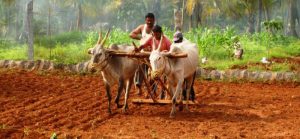One of my earliest observations during COP22 was how difficult it was to get an on-the-ground understanding of the topics discussed. While buzzwords and lofty phrases became familiar (such as ‘environmental integrity’ and ‘facilitative dialogue’), it was difficult for me to ascribe practical meaning to this language. On one level, this carefully constructed language is incredibly important and exciting. These words and phrases represent the discourse and agreement among nations – the highest level of negotiation and policy we can currently imagine. On another level, the painstakingly crafted discourse can seem far-off from the real world. The connection between high-level discussions to on-the-ground impact often proves difficult to draw.
I found this disconnect evident as I tracked my topic area, agriculture, throughout the week. Country delegates pored over negotiating texts for hours – giving attention to every word, punctuation mark, and even capitalization. Meanwhile, side events relating to agriculture occurred in tandem with these informal negotiations. They gave real-life perspectives ranging from smallholder and subsistence farmers to country-wide programs. These concurrent events proved difficult to tie together. Some countries that presented strides in altering agricultural practices in side events did not show any progression in negotiations. Specific agricultural practices and extension services were discussed at length during side events and barely mentioned in the negotiating text.
Of course, some of these issues must be viewed in the context of high-level negotiations. Often, countries’ individual practices and even their own positions can be in conflict with other parties in their negotiating bloc. Internal negotiations among blocs as large and diverse as the G77 + China can be a microcosm of the larger negotiations, adding another level of complexity. Additionally, the issue of scale is undeniable in identification of agricultural best practices. What may be an effective practice in a tropical agricultural zone that grows mostly rice could be completely wasteful in a more temperate area that grows mostly wheat.
These are significant – but not insurmountable – issues. It is already promising that so much action is occurring off of the international stage of negotiation. The next steps, for countries that are serious about achieving a substantive decision on agriculture, may be to increase engagement with this action. Country delegates must gain an on-the-ground understanding of how agriculture is changing with the climate and how their farmers are adapting. Cooperation and communication must occur in settings with similar crop and climate conditions.
Personally, my engagement with agriculture during the COP did not come into a real-world perspective until I came back to Duke. The day after I returned, I attended an event held by the manager of the Duke Farm, Saskia Cornes. As we ate food grown at the one-acre farm, she gave her perspective on “sustainable agriculture” and what it actually means to an operation like the Duke Farm. It was incredibly humbling to get a glimpse of the labor and care that accompanies the production of food in this setting. Connection between ideas and actions – what so often seems to be missing at the COP – was concrete, displayed on the plate in front of me.
